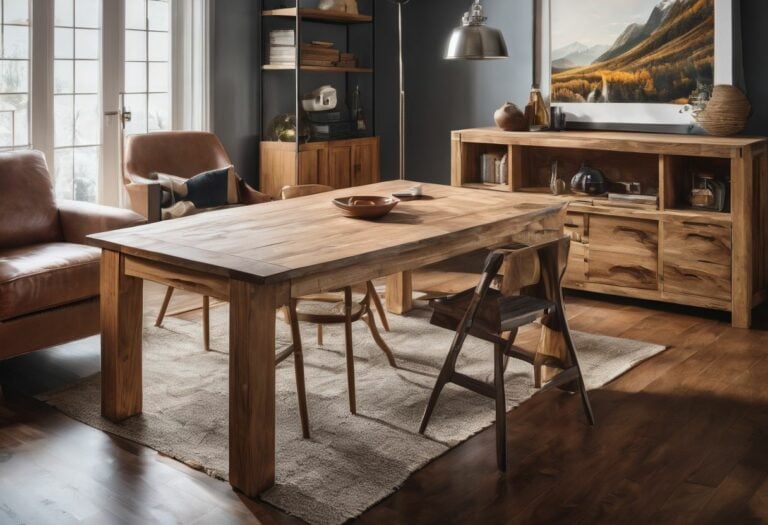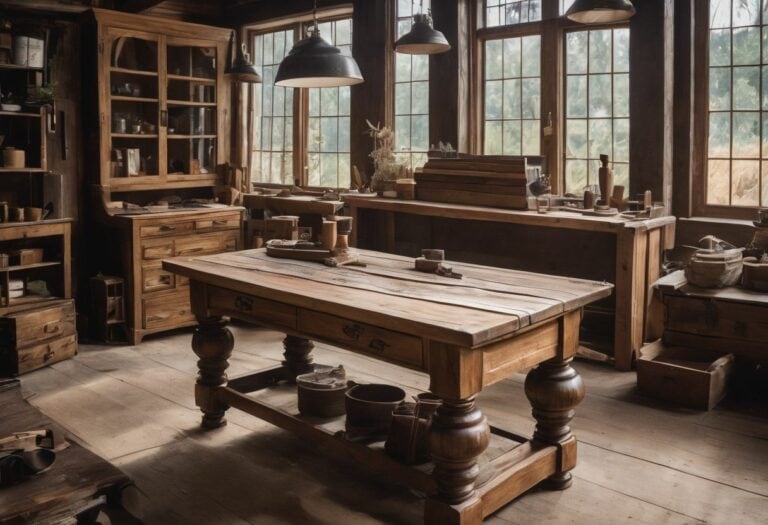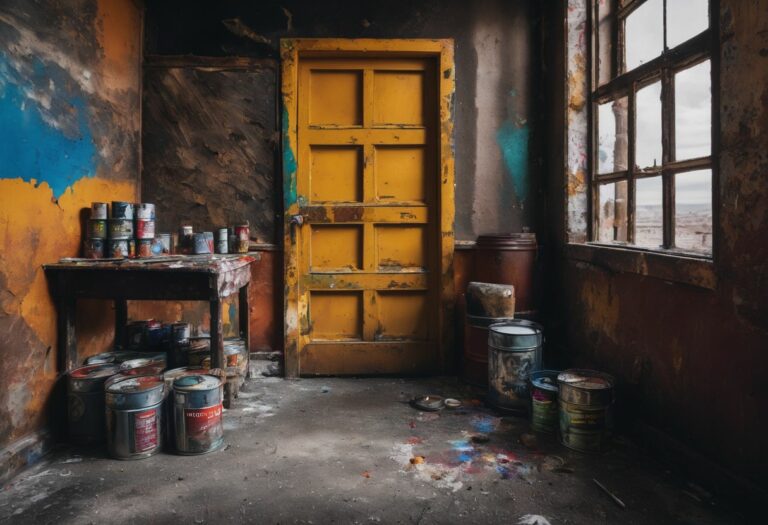How to Restore Weathered Wood Furniture: 4 Steps Guide
If you’re like me, seeing your favorite outdoor wooden furniture pieces get worn and weathered by the elements can be a bit heartbreaking. Not to mention, the prospect of replacing them can leave a hefty dent in your wallet.
But don’t despair! In my quest to salvage my own beloved items, I’ve learned that it’s completely possible to restore these distressed beauties back to their former glory – with just a little elbow grease! In this blog post, we’ll explore an easy-to-follow guide on how to restore weathered wood furniture and keep it safeguarded for many happy seasons ahead.
So grab your work gloves and let’s give those cherished pieces another chance against time!
Key Takeaways
- Weathered wood furniture can be restored back to its former glory with some simple steps.
- Sun exposure can cause fading and warping, while rain and moisture can lead to rotting and mold growth.
- To restore weathered wood furniture, you will need sandpaper, wood cleaner, wood stain or paint, and a protective sealant.
- Steps include prepping and cleaning the furniture, sanding the wood in the direction of the grain, priming if necessary, and applying a high-quality finish.
Understanding the Effects of Weather on Wood Furniture
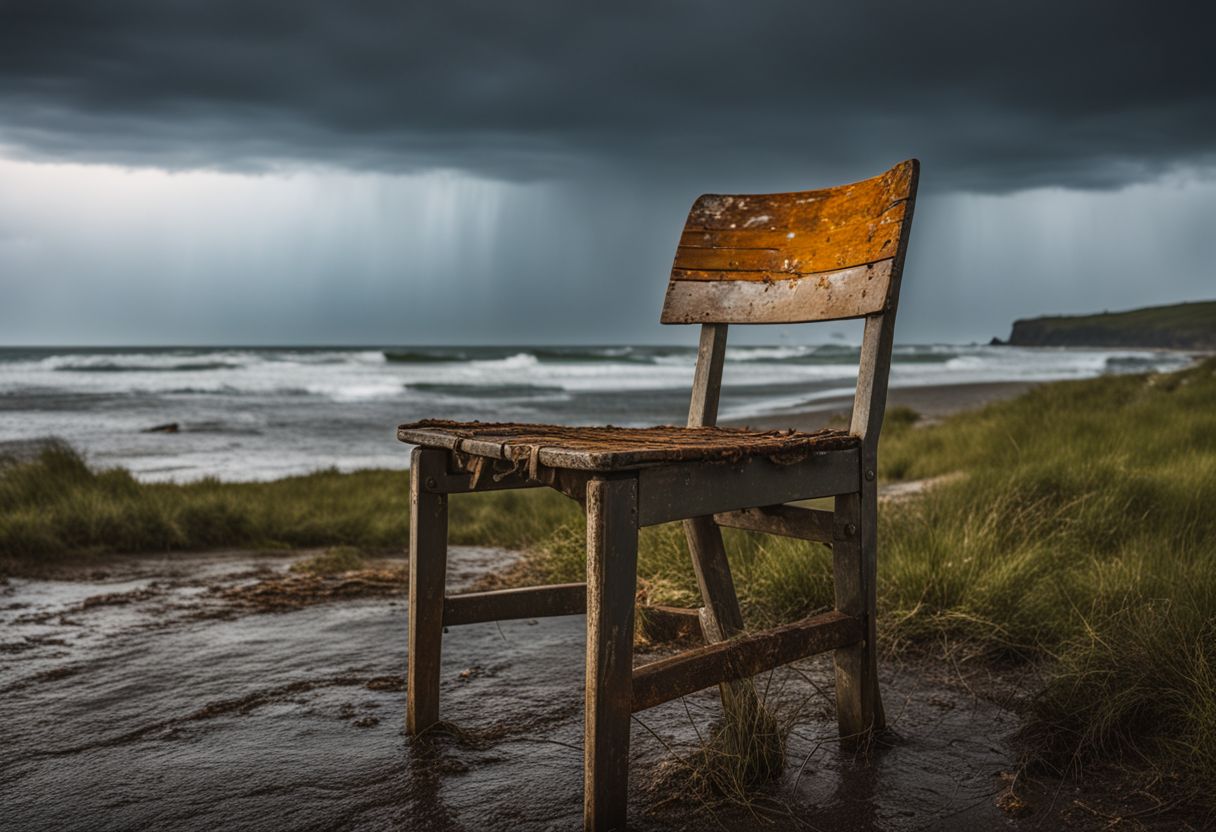
Exposure to sunlight can cause wood furniture to fade and dry out, while rain and moisture can lead to rotting and warping. Additionally, mold and mildew growth can occur in damp conditions, further deteriorating the wood.
Sun exposure
The sun can hurt your wood furniture a lot. It’s not just about heat. UV rays from the sun cause most of the harm. They can take away all the shine from your hardwood pieces. This is what we call fading.
Sometimes, the colors even start to look different. This is discoloration and it’s bad news for your furniture too! Also, if they stay under the sun for too long, they might bend or twist out of shape! That’s called warping, and it makes your furniture look old way before its time!
Rain and moisture
Rain and moisture can spell trouble for wood furniture. They soak into the wood, causing it to swell up. This swelling can twist and warp your furniture, giving it a worn look. The constant wet-dry cycle makes things worse, leading to cracks in the surface.
Water exposure doesn’t stop there! It also invites nasty problems like mold growth, staining, and fungal infestation. Dampness brings on these issues faster than you’d think. In winter, moisture trapped inside your wooden pieces may lead to decay if not handled right away.
So don’t wait until spring cleaning rolls around – start protecting your beloved furniture today!
Mold and mildew growth
Mold and mildew can harm your wood furniture. They like wet places and grow fast. You can see them as black, green, or white spots on your furniture. Sometimes you can even smell a bad odor from them.
If not cleaned fast, mold and mildew can rot the wood. This damage is hard to fix. People may throw out their furniture because of it. Moreover, mold might make people sick by causing allergies or other health problems like asthma or infections! To stop this issue, we need to keep our furniture dry always and use actions that guard against these tiny enemies!
Supplies Needed for Restoring Weathered Wood Furniture
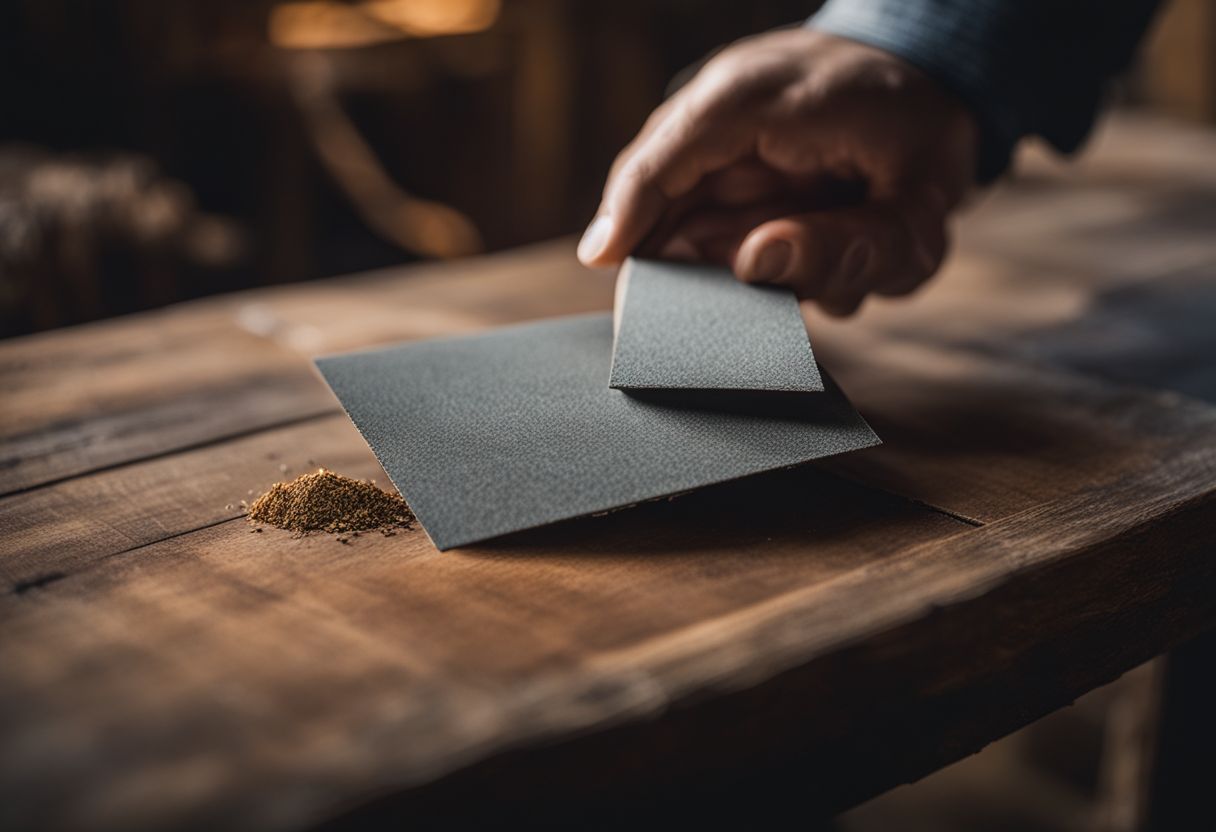
To restore weathered wood furniture, you will need sandpaper, wood cleaner, wood stain or paint, and a protective sealant.
Sandpaper
Sandpaper is a crucial tool for restoring weathered wood furniture. It helps in removing old finishes, paint, and stains from the surface of the wood. When sanding, it’s important to choose the right grit sandpaper for the task at hand.
For tough paint or stain removal and rounding corners, coarse sandpaper with a grit range of 40-60 is recommended. After using medium-grit sandpaper to strip off the old finish, you can switch to a finer grit for a smoother surface.
To make sanding easier and more efficient, use a sanding block instead of your bare hands. Remember that proper sanding prepares your furniture for painting or staining, so be sure to follow the process carefully and achieve satisfying results.
Wood cleaner
Wood cleaner is an essential supply needed to restore weathered wood furniture. It helps to remove dirt, grime, and old finishes from the surface of the wood. When mixed with ingredients like olive oil, denatured alcohol, gum turpentine, and strained lemon juice, wood cleaner becomes a powerful solution for cleaning and protecting your furniture.
As part of the step-by-step guide to restoring your furniture, using a wood cleaner is crucial in preparing the wood for sanding and refinishing. By applying the wood cleaner and following proper dusting and cleaning techniques, you can bring back the natural beauty of your weathered wood furniture.
Wood stain or paint
When it comes to restoring weathered wood furniture, choosing the right finish is important. Whether you decide to use wood stain or paint, both options can help protect your furniture from the effects of weather.
Wood stain enhances the natural beauty of the wood while providing a protective barrier against sun and moisture damage. On the other hand, paint offers more color choices and can completely transform the look of your furniture.
Whichever option you choose, make sure to select a high-quality product that is specifically designed for outdoor use. Applying multiple thin coats and allowing each coat to dry completely will ensure a durable and long-lasting finish.
Protective sealant
To protect your restored weathered wood furniture, applying a protective sealant is essential. A protective sealant helps to shield the wood from sun exposure, rain, moisture, and mold or mildew growth.
It acts as a barrier that prevents moisture from penetrating the wood and causing damage over time. When choosing a sealant, consider options like polyurethane, varnish, or lacquer known for their excellent waterproofing properties.
Applying the sealant when temperatures are moderate between 60 and 80 degrees Fahrenheit ensures proper drying and adherence to the wood surface. By applying a protective sealant to your furniture, you can help extend its lifespan and keep it looking beautiful for years to come.
How to Restore Weathered Wood Furniture in 4 Steps
Follow these four steps to restore your weathered furnitures:
Step 1: Prep and Clean the Furniture
To begin restoring your weathered wood furniture, start by thoroughly prepping and cleaning the pieces. Remove any old finish or debris using a paint eater tool or sandpaper. Then, use a wood cleaner or vinegar solution to clean the surface, making sure to remove any dirt or grime.
Once cleaned, let the furniture dry completely before moving on to the next step of the restoration process.
Remove any old finish or debris
To restore weathered wood furniture, the first step is to remove any old finish or debris. This is important because it helps prepare the furniture for the restoration process. You can use sandpaper or a stripping agent to get rid of the old finish.
Start with coarse grit sandpaper and gradually move on to finer grits for a smooth surface. Once you’ve removed the old finish, make sure to thoroughly clean the furniture to get rid of any remaining debris.
Doing this will help protect the wood and ensure that your restoration efforts are successful.
Use a wood cleaner or vinegar solution
To restore weathered wood furniture, it’s important to start by prepping and cleaning the piece. One effective way to do this is by using a wood cleaner or vinegar solution. You can mix equal parts of olive oil, denatured alcohol, gum turpentine, and strained lemon juice to create a natural cleaning solution for grimy wood furniture.
Alternatively, distilled vinegar is a mild cleaning agent that works well on most types of wood furniture. Simply apply the cleaner or vinegar solution onto a clean cloth and gently wipe down the surface of the furniture.
This will help remove any dirt and grime buildup, preparing it for further restoration steps.
Let dry completely
After prepping and cleaning the furniture, it’s crucial to let the wood dry completely before moving on. This step is essential for a successful restoration process and protecting your weathered wood furniture.
The drying time will depend on factors like temperature and humidity levels. Make sure to give the wood enough time to dry thoroughly before proceeding with the next steps. By allowing the wood to dry completely, you’ll ensure that the restoration process goes smoothly and your furniture stays protected for years to come.
Step 2: Sanding the Wood
To sand the wood, start by choosing an appropriate grit sandpaper and make sure to sand in the direction of the wood grain. Remove all dust and debris before moving on to the next step.
Choose the appropriate grit sandpaper
For step 2 of restoring weathered wood furniture, it’s important to choose the right grit sandpaper. The grit level determines how rough or smooth the sandpaper is. In general, a lower grit number like 80 or 100 is coarser and more abrasive, while a higher grit number like 220 or 320 is finer and less abrasive.
If your furniture has heavy damage, you may want to start with a lower grit sandpaper to remove any rough spots or peeling paint. Then, gradually move up to a higher grit to achieve a smoother surface.
Remember to always sand in the direction of the wood grain for best results.
Sand in the direction of the wood grain
When sanding weathered wood furniture, it’s important to always sand in the direction of the wood grain. This helps to smooth out the surface and prepare it for staining or finishing.
Sanding against the grain can cause scratches and damage to the wood, creating a rough texture that makes it more difficult to achieve a smooth finish. By following this proper sanding technique, you can protect and enhance the natural beauty of the wood while ensuring an even and consistent sanding process.
Remove all dust and debris
To restore weathered wood furniture, it’s important to start by removing all dust and debris. This step ensures that the wood is clean and ready for further restoration. After sanding the wood, there may be leftover dust and particles on the surface.
To get rid of them, you can use a vacuum cleaner or a cloth to thoroughly clean the area. By doing this, you’ll have a smooth surface to work with and ensure better results in the next steps of the restoration process.
With a clean foundation, your wood furniture will be ready to regain its beauty and prolong its lifespan.
Step 3: Prime the Wood (if necessary)
After sanding, it’s important to prime the wood before applying paint or stain. This step ensures better adhesion and a smoother finish. Find out the right primer for your wood type and learn how to apply it correctly in our step-by-step guide.
Choose the right primer for your wood type
When choosing a primer for your wood furniture, it’s important to consider the type of wood you are working with. Different types of wood require different primers for optimal results.
For painted or stained wood, a stain-blocking primer is recommended. This type of primer helps to prevent any discoloration or bleeding from the old finish. If you are working with older, weathered wood, it is best to use a high-quality latex or oil-based primer.
These primers help to seal and protect the wood from further damage. When applying the primer, using a disposable chip brush can make the process easier and more efficient. Lastly, don’t forget that even new wood should be primed before painting to ensure better adhesion and longer-lasting results.
Apply an even coat and let dry
After sanding and priming the wood, it’s time to apply an even coat of paint or stain. This will give your furniture a fresh new look while protecting it from the weather. Make sure to choose a high-quality finish that is resistant to sun, rain, and mold.
Apply multiple thin coats for the best results, allowing each coat to dry completely before applying the next one. Don’t forget to seal your newly restored wood furniture with a protective sealant to keep it looking great for years to come!
Step 4: Paint or Stain the Furniture
Once the wood is prepped and sanded, it’s time to bring new life to your weathered furniture with a fresh coat of paint or stain. Learn the best techniques for applying a beautiful finish that will protect and enhance your pieces – click here to discover the secrets!
Choose a high-quality, weather-resistant finish
I recommend choosing a high-quality, weather-resistant finish for your wood furniture. This is important because it will help protect the wood from sun exposure, rain, moisture, and mold or mildew growth.
Look for finishes that are durable, water-resistant, and provide UV protection to prevent fading. Make sure to select an exterior-grade finish that is specifically designed for outdoor use.
Applying multiple thin coats of the finish will ensure better coverage and longevity. Use a paintbrush or a cotton rag to apply the finish evenly onto the surface of your furniture.
Apply multiple thin coats
When painting or staining weathered wood furniture, it is important to apply multiple thin coats. This technique helps achieve a smooth and even finish while providing better protection for the wood.
To apply multiple thin coats, you can use a paint brush or a cotton rag to spread the paint or stain in thin layers. It is crucial to allow each coat to dry completely before applying the next one.
This method, known as dry brushing, helps create the desired weathered wood finish and ensures that your furniture stays protected from the elements.
Let dry completely between coats
Each coat of paint or stain should be allowed to dry completely before applying the next coat. This is important for several reasons. First, drying time ensures proper adhesion between layers, preventing peeling or uneven coverage.
Second, it allows the coating to penetrate and bond effectively with the wood surface, resulting in a more durable finish. Finally, letting each coat dry completely helps achieve a smooth and flawless final result.
So, when restoring weathered wood furniture, be patient and let your coats dry thoroughly before moving on to the next step.
Protecting and Maintaining Your Restored Wood Furniture
To ensure long-lasting results, apply a protective sealant to your restored wood furniture and consider using furniture covers or moving them indoors during inclement weather. Regularly clean and maintain the finish to keep it looking beautiful for years to come.
Apply a protective sealant
Applying a protective sealant to your restored wood furniture is an essential step in preserving its beauty and durability. A sealant helps protect the wood from moisture, preventing discoloration, cracks, and even mold growth.
It also adds a layer of scratch resistance and dirt protection. When choosing a sealant, opt for one that is specifically designed for outdoor use and provides good moisture resistance.
Make sure to follow the manufacturer’s instructions for application, applying it evenly over the entire surface of the furniture. By applying a protective sealant, you can ensure that your restored wood furniture stays looking great for years to come.
Use furniture covers or move indoors during inclement weather
To protect your restored wood furniture from damage, it’s important to use furniture covers or move them indoors when the weather is bad. This can help prevent the harsh effects of rain and other inclement weather conditions.
When left outside without any cover, wood furniture is more susceptible to wear and tear caused by sun exposure and moisture. By taking this simple precaution, you can prolong the life of your furniture and minimize the need for further repairs or restoration.
So remember, always cover your outdoor furniture or bring it inside during bad weather to keep it looking its best for years to come.
Regularly clean and maintain the finish
To keep your restored wood furniture looking its best, it’s crucial to regularly clean and maintain the finish. Routine maintenance is key for preserving the appearance and upholding the finish of your furniture.
By ensuring that you regularly clean and protect the surface, you can prevent damage and extend the longevity of your beloved pieces. Make sure to apply a protective sealant to safeguard against wear and tear, use furniture covers or move indoors during inclement weather, and consistently clean and maintain the finish.
Remember, taking care of your restored wood furniture through regular upkeep is essential for sustaining its restored look and preserving its integrity for years to come.
Other Tips for Restoring and Protecting Outdoor Furniture
Consider using environmentally-friendly products for your wood restoration projects. Look for low VOC (volatile organic compound) options that are less harmful to the environment and your health.
Additionally, using recycled or reclaimed wood can be a sustainable choice that adds character to your outdoor furniture while reducing waste.
Consider using environmentally-friendly products
When restoring and protecting outdoor furniture, it’s important to consider using environmentally-friendly products. By choosing sustainable options, such as eco-friendly finishes and natural wood care solutions, you can help reduce your impact on the environment.
Look for nontoxic finishes and biodegradable outdoor products that are safe for both your furniture and the planet. Additionally, using recycled or reclaimed materials for outdoor furniture is a great way to promote sustainability.
Reclaimed teak from old houses and barns, for example, can be used to create beautiful and eco-conscious pieces. By making these choices, you can enjoy your outdoor space while being mindful of the Earth.
Use recycled or reclaimed wood for a sustainable option
Using recycled or reclaimed wood for your outdoor furniture is a great choice if you want to be sustainable. Reclaimed wood comes from old structures or furniture that would otherwise be thrown away.
By using this type of wood, you are giving it new life and reducing the demand for freshly cut trees. This helps to conserve natural resources and minimize waste. Not only is reclaimed wood environmentally friendly, but it can also add unique character and charm to your furniture pieces.
So, consider using recycled or reclaimed wood for a more eco-friendly option when restoring and protecting your outdoor furniture.
Conclusion
In conclusion, restoring weathered wood furniture can be a rewarding DIY project that helps prolong the life of your beloved pieces. By following the step-by-step guide provided in this article, you can bring back the beauty and protect your outdoor wooden furniture for years to come.
Remember to prep and clean the furniture thoroughly, sand it down to create a smooth surface, apply a primer if needed, and finish with a high-quality paint or stain. Don’t forget to regularly maintain and protect your restored furniture by applying a protective sealant and taking precautions during inclement weather.
Enjoy your revitalized wooden pieces!
FAQs
1. What tools do I need to restore weathered wood furniture?
You will need sandpaper, a paintbrush or foam brush, wood stain or paint, and a sealant or varnish.
2. Can I restore weathered wood furniture without any experience?
Yes, you can restore weathered wood furniture even if you don’t have prior experience. Just follow the step-by-step guide carefully and take your time.
3. How long does it take to restore weathered wood furniture?
The time it takes to restore weathered wood furniture depends on the condition of the piece and the size of the project. It can range from a few hours to several days.
4. How often should I protect my restored wood furniture?
It is recommended to regularly clean and apply a new coat of sealant or varnish every 1-2 years to maintain its protection.
5. Can I use any type of stain or paint for restoring my wood furniture?
No, it’s important to choose a stain or paint specifically designed for indoor or outdoor use depending on where your furniture will be placed. Make sure it is suitable for wooden surfaces as well.




